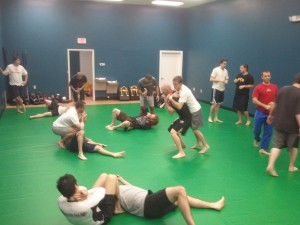 In part 1, I outlined reasons why training in the gi is valuable for your no-gi training. Now I’m going to really confuse you and give you seven reasons why training no-gi is important for your gi game.
In part 1, I outlined reasons why training in the gi is valuable for your no-gi training. Now I’m going to really confuse you and give you seven reasons why training no-gi is important for your gi game.
The merits of training no-gi from time to time are quite obvious to most with regard to self-defense and MMA training, so I won’t go into them in this article. Instead, I’m going to convince you that training no-gi is good for your overall grappling- and even your gi training.
1. Training no-gi helps you figure out basic body positioning, not where pieces of cloth are supposed to go.
You will get a much deeper understanding of physiological points of control, and this will easily translate over to your gi grappling. Learning to redirect hips and pin shoulders is crucial to a good guard passing game. Understanding where the body needs to go gives you insight into how to pass, sweep, and take your opponent down with greater efficiency.
2. You will be forced to learn different methods of grappling- nearly all of which carry over to gi training.
Butterfly guard, X-guard, and especially one-legged X-guard, are incredibly easy to enter into in no-gi. These amazingly efficient types of guard to play both with and without the gi, but because of the ease of entry, you will be able to practice them a great deal in no-gi. Your passing style will change a great deal by adding in no-gi training as you learn to utilize underhooks and overhooks. Takedowns and throws that use lower body control and even some upper body takedowns that stem from Greco-Roman wrestling can easily be integrated into a good judo game.
3. The speed factor of no-gi will force you to learn to react much more quickly.
The speed of no-gi makes your brain think in a more intuitive, less analytic manner. This different way of interpreting situations uses a different part of your brain than you may be used to if you’re only training in the gi right now, and you will come up with some innovative answers to the problems your partner presents to you.
4. The speed factor will also help you learn to control your opponent more effectively.
In order to slow things down in no-gi, you will have to develop a different type of pressure than you may be used to with the gi. You learn tips and tricks like pinching your elbows to your sides from side control, or squeezing your knees in the mount- hidden details you might not otherwise discover if you’re simply relying on friction and handles with the gi.
5. If you’re a competitor, you have more than twice as many opportunities to compete.
There are quite a lot of no-gi tournaments out there nowadays, and most tournaments offer both gi and no-gi divisions. Add to this the fact that it can be very difficult to find gi matches the higher the rank of your belt, and it’s a no-brainer: no-gi gives you a lot more options to compete.
6. You learn to finish submissions much more efficiently in no-gi.
Because escapes are easier (due in large part to the sweat factor, and to the lack of friction), you will have to hone your finishing skills in no-gi. Your knees will need to be squeezed together tightly to finish that armlock, and your triangle choke has to rely on true posture control. You’ll find dozens of other areas where your finishes improve in the gi by training no-gi.
7. Your fingers will thank you.
We do “No-Gi November” every year at Revolution BJJ. This is an excellent chance for my hands to get a break from all the constant gripping with the gi (we have 14 gi classes per week at my gym, as opposed to 4 no-gi classes). Training no-gi every so often will give your knuckles a chance to stop aching for a few days, and you can come back to choke your partners anew.
No matter what your objectives, you should try training a little no-gi. It might well change your game.